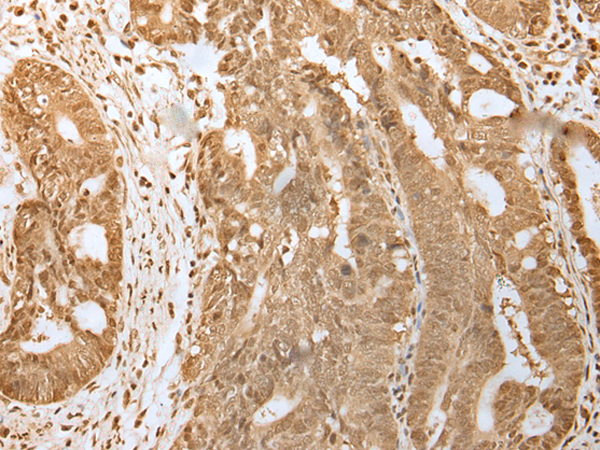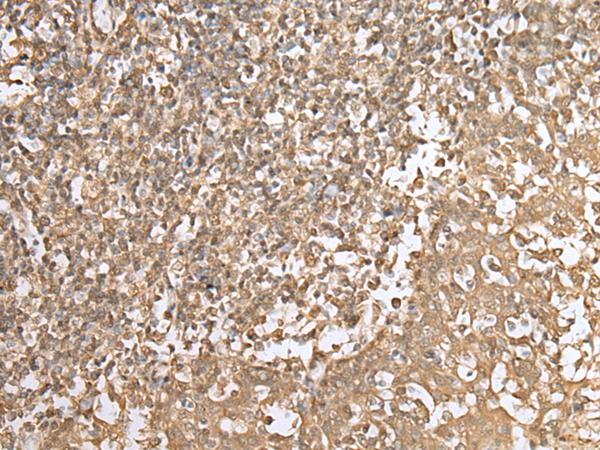

| WB | 咨询技术 | Human,Mouse,Rat |
| IF | 咨询技术 | Human,Mouse,Rat |
| IHC | 1/25-1/100 | Human,Mouse,Rat |
| ICC | 技术咨询 | Human,Mouse,Rat |
| FCM | 咨询技术 | Human,Mouse,Rat |
| Elisa | 1/5000-1/10000 | Human,Mouse,Rat |
| Aliases | HD5; NY-CO-9 |
| Host/Isotype | Rabbit IgG |
| Antibody Type | Primary antibody |
| Storage | Store at 4°C short term. Aliquot and store at -20°C long term. Avoid freeze/thaw cycles. |
| Species Reactivity | Human, Mouse |
| Immunogen | Synthetic peptide of human HDAC5 |
| Formulation | Purified antibody in PBS with 0.05% sodium azide and 50% glycerol. |
+ +
以下是3篇关于HDAC5抗体的参考文献及其摘要概括:
---
1. **标题**:*Histone Deacetylase 5 Acquires Calcium/Calmodulin-Dependent Kinase II Responsiveness by Oligomerization with Histone Deacetylase 4*
**作者**:Mihailovich, M., et al. (2008)
**摘要**:该研究通过Western blot和免疫荧光技术,利用HDAC5抗体揭示了HDAC4/5异源二聚化在响应钙信号通路中的作用,发现这种相互作用增强了HDAC5对钙调蛋白激酶II(CaMKII)的敏感性,从而调控其在心肌细胞中的核质穿梭。
2. **标题**:*HDAC5 and Its Target Gene, Npas4. Function in the Nucleus Accumbens to Regulate Cocaine-Conditioned Behaviors*
**作者**:Taniguchi, M., et al. (2017)
**摘要**:通过免疫组化及ChIP-qPCR实验结合HDAC5特异性抗体,研究发现HDAC5在伏隔核中通过表观遗传机制抑制转录因子Npas4的表达,进而调控小鼠对可卡因成瘾相关行为的记忆形成。
3. **标题**:*Phosphorylation of HDAC5 by Protein Kinase D Regulates Neuronal Survival*
**作者**:Majdzadeh, N., et al. (2008)
**摘要**:该研究利用HDAC5磷酸化特异性抗体,证明蛋白激酶D(PKD)介导的HDAC5 Ser259/Ser498位点磷酸化促进其核输出,从而解除对神经营养因子BDNF转录的抑制,增强神经元存活能力。
---
以上文献均涉及HDAC5抗体的实验应用(如Western blot、免疫组化、ChIP等),并探讨了HDAC5在信号转导、神经疾病及表观遗传调控中的关键作用。
Histone deacetylase 5 (HDAC5) is a class IIa enzyme within the HDAC family, which plays a critical role in regulating gene expression by removing acetyl groups from histones, leading to chromatin condensation and transcriptional repression. HDAC5 is involved in diverse cellular processes, including muscle differentiation, cardiac development, neuronal plasticity, and stress responses. It shuttles between the nucleus and cytoplasm, with its activity modulated by post-translational modifications, such as phosphorylation, which regulates its subcellular localization and interaction with transcription factors (e.g., MEF2. GATA) or co-repressors. Dysregulation of HDAC5 has been linked to diseases like cancer, neurodegenerative disorders, and cardiovascular pathologies.
HDAC5 antibodies are essential tools for studying its expression, localization, and molecular mechanisms. These antibodies are widely used in techniques such as Western blotting, immunohistochemistry (IHC), immunofluorescence (IF), and chromatin immunoprecipitation (ChIP) to detect HDAC5 protein levels, assess its nuclear-cytoplasmic shuttling, or identify target genes. Specific antibodies can distinguish between phosphorylated (inactive, cytoplasmic) and unmodified (active, nuclear) forms, providing insights into signaling pathways (e.g., CaMK or PKD pathways) that regulate HDAC5. Researchers also utilize HDAC5 antibodies to explore its role in epigenetic therapies, as HDAC inhibitors are investigated for treating cancer and neurological diseases. Validation of antibody specificity via knockout controls or peptide blocking ensures reliable experimental outcomes in both basic and clinical research.
×